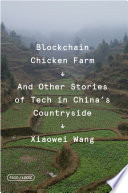

One of the central themes of 'Blockchain Chicken Farm' is the application of blockchain technology to enhance transparency in various sectors, particularly in agriculture. The book illustrates how blockchain can provide a tamper-proof ledger that records every transaction, ensuring that all stakeholders—from farmers to consumers—can trace the origin of their food products. This transparency is crucial in combating issues like food fraud, which can have dire consequences on public health and trust in food systems. The author discusses various case studies where blockchain has been implemented, showcasing how it can empower farmers by giving them direct access to markets and fair pricing, ultimately leading to a more equitable food supply chain.
Continue readingThe book delves into the concept of decentralization, which is a core principle of blockchain technology. By removing intermediaries, blockchain enables direct transactions between parties, thereby empowering individuals and small businesses. For farmers, this means they can sell their products directly to consumers without relying on middlemen who often take a significant cut of the profits. This idea is explored through various narratives that highlight how decentralized systems can lead to greater autonomy for producers and can stimulate local economies. The author emphasizes that this empowerment can help alleviate poverty and improve livelihoods, particularly in developing regions.
Continue readingIn 'Blockchain Chicken Farm', the author examines the broader implications of technology in agriculture beyond just blockchain. The book discusses how advancements in technology, such as IoT (Internet of Things) devices and AI (Artificial Intelligence), are transforming farming practices. These technologies can optimize resource use, enhance productivity, and provide farmers with data-driven insights to make better decisions. The author illustrates the synergy between these technologies and blockchain, suggesting that together they can create a more sustainable and efficient agricultural system. This integration is critical for addressing global challenges like food security and climate change.
Continue readingThe book highlights innovations in supply chain management that are made possible by blockchain technology. By creating a transparent and immutable record of transactions, blockchain can help track the journey of food products from farm to table. This not only enhances food safety by allowing for quick recalls in case of contamination but also builds consumer trust. The author provides examples of companies that have successfully implemented blockchain in their supply chains, illustrating how these innovations can lead to reduced waste, lower costs, and improved efficiency. The discussion extends to the potential for real-time data sharing among all stakeholders in the supply chain.
Continue readingConsumer behavior is another critical aspect discussed in the book. The author argues that as consumers become more aware of the origins of their food and the ethical implications of their purchases, they will demand greater transparency from producers. Blockchain can facilitate this by providing verifiable information about food products, such as where they were grown, how they were processed, and whether they meet certain ethical standards. This shift in consumer expectations is driving businesses to adopt more transparent practices, and the book emphasizes the importance of engaging consumers in the conversation about food systems and sustainability.
Continue readingWhile the book is optimistic about the potential of blockchain technology, it does not shy away from discussing the challenges and limitations associated with its implementation. Issues such as scalability, energy consumption, and the need for industry-wide standards are addressed. The author also points out that technology alone cannot solve systemic problems in agriculture; it must be combined with policy changes, education, and community engagement. This balanced perspective encourages readers to think critically about the role of technology in society and the need for holistic solutions to complex issues.
Continue readingThe final key idea revolves around the future of food systems in light of technological advancements. The author posits that embracing blockchain and other emerging technologies can lead to a more resilient and sustainable food system. This vision includes not only improved efficiency and transparency but also a focus on social equity and environmental stewardship. The book concludes with a call to action for stakeholders at all levels—farmers, consumers, policymakers, and technologists—to collaborate in shaping a food system that prioritizes health, sustainability, and fairness.
Continue reading